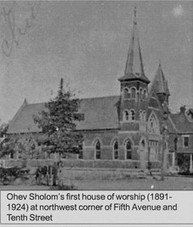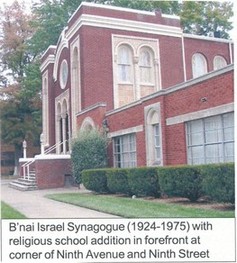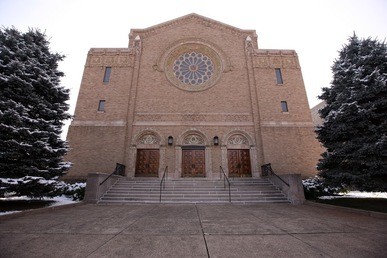Ohev Sholom Temple
Introduction
Text-to-speech Audio
Images
The first house of worship for Ohev Sholom. 1891-1924

B'nai Israel Synagogue. 1924-1975

B'nai Sholom

The first house of worship for Ohev Sholom. 1891-1924

B'nai Israel Synagogue. 1924-1975

B'nai Sholom

Backstory and Context
Text-to-speech Audio
The first recorded members of the Jewish faith to settle in Huntington West Virginia were Samuel and Dora Gideon, who had moved from Cincinnati, Ohio, in 1872. The late 1880s brought more people of the Jewish faith to Huntington, and a religious and social organization called the Almonia Social Club was formed. Gideon and Emanuel Biern formed a minyan, a quorum of ten men or women over the age of 13 required for traditional Jewish public worship, in 1884. Members of the Almonia Social Club formed the Ohev Sholom in 1887 along with the first Jewish religious school in Huntington. In 1889, Ohev Sholom became a chartered religious institution, and in 1891 adopted the Reform Jewish ritual. Ohev Sholom's first house of worship was on the corner of 5th Avenue and 10th Street, with the first performance in 1892. The Jewish population of Huntington grew from 150 in 1910 to 350 in 1917; Ohev Sholom outgrew their first house of worship and plans were made to construct a new one at 10th Avenue and 10th Street. The new house of worship was completed in 1924, however, it almost did not survive the crash of the stock market. Ohev Sholom could not afford a Rabbi for nearly ten years, and in that time the services were led by student rabbis until 1939. After World War II, the Jewish population in Huntington grew once again, and Ohev Sholom was reported as having 175 members in 1953. Many of the congregation's fourth-generation members began moving from Huntington, which affected Ohev Sholom financially. In the 1970s, a merger with B'nai Israel Synagogue occurred so that the congregation could be saved.
After a twenty-year effort, B'nai Israel Synagogue was established by a small group of Orthodox Jews and held their first meeting in Mickel's Hall on Third Avenue. B'nai Israel Synagogue rented spaces throughout Huntington for the next 14 years, until their house of worship was established on the corners of 9th Street and 9th Avenue in 1924. B’nai Israel established a Hebrew School and a religious school, which had 23 students total in 1957. In the late 1960s, B’nai Israel consolidated schools with Ohev Sholom as B’nai Israel did not have an adequate facility. Over the years, B’nai Israel migrated from the Orthodox Jewish practice to the more moderate Conservative Jewish practice. As with Ohev Sholom, B'nai Israel experienced a financial downfall in the late 1960s when the younger generation of members decided to move for better opportunities.
Ohev Sholom as B’nai Israel met in the early 1970s to discuss their merger and agreed upon one single Rabbi to accommodate all services. The merger officially happened in 1974 on the terms that The ritual practices of B'nai Sholom would primarily follow the practices of Reform Judaism at Friday night Shabbat service, and conservative Judaic practice would prevail at Saturday morning Shabbat service and Sunday morning weekday service. For four years services were split between both locations, and in 1974 B'nai Sholom had fully moved into the Ohev Sholom house of worship due to it's larger size. Rabbi Jean Eglinton, who was ordained at Hebrew Union College in Cincinnati, is the current rabbi for B'nai Sholom.
Sources
“Our History.” Accessed November 17, 2016. http://www.wv-bnaisholom.org/our-history.html.
